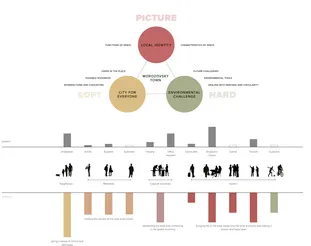Rehab-Inhabit-Habitat
Redevelopment of Morozovsky town.

ALEXANDRA BAYBORODOVA - MASTER THESIS ARCHITEKTUR - SOMMER 2021
The factory town was built in the late 19th - early 20th centuries at a weaving and spinning enterprise: everything was there for a comfortable life for workers. A century later, ruins and devastation remained from the business of the Morozov manufacturers. In the place of industrial buildings there are now shops, and residential barracks have turned into slums, which are scary to enter. Today, those who remember that original, Morozovsky town, are few, and few know how majestic it was 100 years ago.
A factory in the middle of the 19th century did not appear in Tver by chance. Farming did not bring much income to the peasants, because the land in the province was poor. And the railroad, which ran through Tver, took money from those who tried to earn money by carriage. But on the other hand, it was the railroad that brought peasants from the suburbs to the city, who were willing to work in manufacturing. Thus factories began to appear in the city.
“In 1856 the Moscow merchants Shibaev, Mityushin, Bryzgalin, Zalogin and Kaulin founded the ‘Tver Manufactory of Paper Products,’” says local historian Konstantin Litvitsky. - Soon afterwards shares of Kaulin, Shibaev, and Zalogin were bought by Savva Morozov. That’s how the history of Morozov’s barracks and Proletarka Yard began.
Savva Morozov (1770—1862) started his way to wealth from scratch. A hereditary peasant, he started working and earning money early, and when he grew up, he engaged in silk weaving, and so successfully that in time he bought himself out from the landowner Ryumin for a fabulous 17 thousand rubles.
Having bought himself, and then the partnership, Morozov leased land on the right bank of the Tmaka River and in 1858 began to build a spinning and weaving building - the main factory of the future workers’ town. In 1859, the first batch of goods came out. Savva Morozov ran the factory untill his death in 1962.
His grandson Abram overtook the business. In 1882, after the death of Abram Abramovich, the business was headed by his wife Varvara Alekseevna, who actually managed the enterprise since 1877. In 1892, her son Ivan took over the business.
In August 1918, the Tverskaya Manufactory was nationalized and four years later it was renamed into the Bolshaya Proletarskaya Tverskaya Manufactory, in abbreviated form - “Proletarka”. In 1942, the factory was transformed into the Kalinin Cotton Mill. After the war, many independent enterprises appeared in the Proletarka Yard: a mechanical plant, a vitamin and silk-weaving factories, a worsted factory. In the nineties, production began to fall apart, and in 2004 the Tver Manufactory was liquidated.




